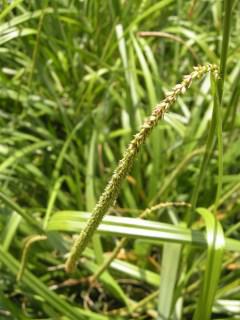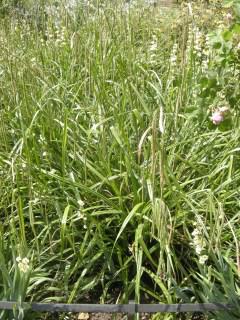
Carex pendula Seed head (30/05/2012, London)
Position: Full sun to shade
Flowering period: Late spring to early summer
Soil: Moist/ wet
Eventual Height: 1.5m
Eventual Spread: 1m
Hardiness: 5a – 9b
Family: Cyperaceae
Carex pendula is a vigorous, clump forming, evergreen, perennial grass. Its mid green leaves are strap like, smooth, triangular in cross section, up to 1.5m long and 2cm wide. Its green drooping flowers are catkin like, borne on tall arching stems above the leaves, each stem containing male and female flowers, the female flowers being up to 25cm long. Its fruit are brown/ green and up to 5mm long. Its roots are rhizomatous.
Carex pendula, commonly known as Pendulous Sedge, Weeping Sedge or Great pendulous Sedge, is native to western, central and southern Europe (including the UK) and north west Africa. In its native habitat it occurs in damp woodlands, scrub lands and stream sides. Carex pendula is synonymous with Carex maxima. This plant will self seed readily, given the correct conditions, and may spread.
The etymological root of the binomial name Carex is from the old Latin name for reed grasses, sedges and rushes. Pendula is derived from the Latin pendeo meaning ‘to hang’.

Carex pendula (30/05/2012, London)
The landscape architect may find Carex pendula useful in naturalist planting schemes, including woodland pond margins. It is also very useful in shady locations where the soils is damp/ wet.
Ecologically, C. pendula provides shelter for amphibians and nectar for insects.
C. pendula prefers moist, fertile soils. It tolerates most pH of soil. It will tolerate heavy soils. It will tolerate permanently wet soils.
Carex pendula requires little maintenance. Self seeded seedling may be removed.

